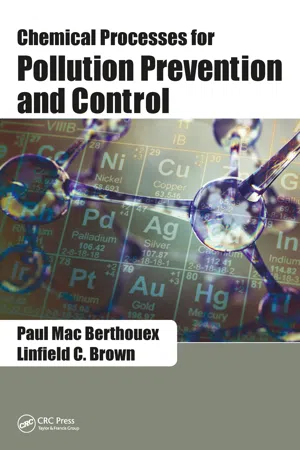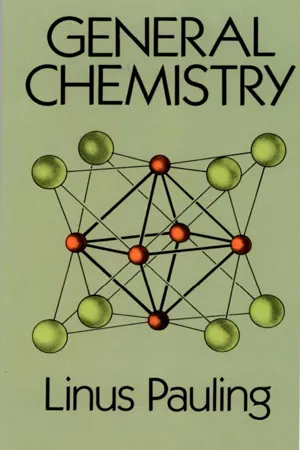Chemistry
pH Scale
The pH scale is a measure of the acidity or alkalinity of a solution, ranging from 0 to 14. A pH of 7 is considered neutral, while lower values indicate acidity and higher values indicate alkalinity. The scale is logarithmic, meaning each unit change represents a tenfold difference in acidity or alkalinity.
Written by Perlego with AI-assistance
Related key terms
11 Key excerpts on "pH Scale"
- Gerald E. McDonnell, Denise Sheard(Authors)
- 2012(Publication Date)
- Wiley-Blackwell(Publisher)
a “gallon” in the US can be a dry or liquid gallon and both are different to the imperial gallon). The pH Scale: defining acids and bases Chemists can use a variety of ways to study and analyse various different types of chemicals and solutions. One such measurement is known as pH, which is a measure of how acidic or alkaline a liquid or solution is. The strict chemical understanding of pH is that it is a measure of the hydrogen ion (H +) concentration in a solution, but this is not considered further. The pH Scale ranges from 0 to 14 (Figure 6.5) and all liquids will fall somewhere on this scale. The mid-range of the scale is at 7, at which a liquid is considered “neutral”, while the more acidic the lower the number (“strong acid”) and the more alkaline (or basic) the higher the number (“strong alkali/base”). An example of a neutral liquid is drinking water (if it is correctly provided) which is generally in the neutral range (pH 6–8). Another is blood that is generally at and maintained at a pH of about 7.4 (this can also be referred to as being slightly alkaline). As liquids are measured to be more acidic (<6) or alkaline/basic (>8), they are considered more aggressive. Some common types of acids are vinegar (which is actually a dilute or watered-down version of an acid known as acetic acid, which has the chemical formula CH 3 COOH or also written as C 2 H 4 O 2), orange juice and lemon juice. Hydrochloric acid (HCl) is produced by the body in the stomach, which gives the stomach contents an acidic pH to aid in the digestive process (see Chapter 2). Examples of alkaline liquids are bleach solutions (a mixture of a chemical known as sodium hypochlorite, NaOCl, in water) and many liquid soaps and detergents. It should be noted that the difference, for example, between a solution of pH 6 and pH 5 is larger than it seems because it is what is referre d to as a “log” scale- eBook - ePub
Environmental Process Analysis
Principles and Modeling
- Henry V. Mott(Author)
- 2013(Publication Date)
- Wiley(Publisher)
eq ).Given the electrochemical nature of the measurement technique, the measured abundance is in fact the chemical activity of the protons in the solution. We have encountered this chemical activity term earlier and determined that detailed consideration must wait until chapter 10 of this text when we are more fully armed with understandings allowing us to fully appreciate its significance. Thus, for now we will revert to the more familiar definition that pH = −log10 [H+ ] (and the reverse that [H+ ] = 10–pH ), leaving examination and application of the true definition that pH = −log10 {H+ } (−log10 of the molar activity of hydrogen ions) until we embrace the advanced topics of Chapter 10.We could delve into the specific electrochemistry of the pH meter, developing full understandings regarding the bases of the measurement process, but will not. These understandings are published in numerous sources. Although vital to the overall understanding of and refinement of methods for the measurement of pH, assimilating these understandings is beyond the scope of this textbook.Let us examine the hydrogen ion (or proton) in light of the discussion of Chapter 2 relative to the attraction of water to ions in aqueous solution. Once its electron is donated from the hydrogen atom, what remains is the proton situated in the nucleus of the ion with a residual unit positive charge. Then, in aqueous solution, water molecules arrange themselves via short-range bonds between the partial negative of the oxygen and the positive charge of the proton. The first four water molecules tend to orient themselves in a tetrahedral structure. The bonds between the coordinating water molecules and the proton are quite strong. We will leave the computation of the bond energy to the physical chemists. Given that these first four water molecules in no way satisfy the positive charge, additional water molecules are free to orient with the resultant proton–water structure, forming another layer, still strongly bonded to the positive charge, but certainly less so than the inner four. Additional layers of water, each with successively weaker bonds, are added to the overall positively charged ionic structure. In discussions of the relation between the ionic content of water and the activity coefficient (relating molar activity to molar concentration), Dean (1992) lists the ion size parameter (the hydrated radius) of the hydrogen ion as nine angstroms (Å). We can then envision (this works best if we close our eyes and imagine that we can see both the proton and the water molecules) a layered sphere, each layer being a spherical shell, of ordered water molecules surrounding the proton. Within each shell the oxygen atom of each water molecule would tend to be oriented toward the center relative to the hydrogen atoms. Figure 6.1 is a two-dimensional, quite simplistic representation of the general configuration. Given that the water molecules, as a consequence of their innate energy manifest as translational, rotational, and vibrational motion are always on the move, the structure would be dynamic with continual exchange of water molecules. Further, rather than orient in “layers” the water molecules might tend to orient in a much less ordered manner. Regardless of the details, we leave Figure 6.1 - eBook - ePub
- Tony Farine, Mark A. Foss(Authors)
- 2013(Publication Date)
- Routledge(Publisher)
When using the pH Scale, a number of points must be considered. First, since it is a logarithmic scale, every change of one unit in pH represents a tenfold change in hydrogen ion concentration, a change of two units in pH a 100-fold change in hydrogen ion concentration, and so on. For this reason, the normal range of blood pH (7.35–7.45) is not as narrow as it first appears, and apparently small changes in blood pH represent large changes in hydrogen ion concentration, which you may need to report. Second, the pH Scale is a negative scale – that is, a falling pH represents a rise in hydrogen ion concentration and a rising pH represents a falling hydrogen ion concentration.Pure water has a pH of 7 and an identical concentration of hydrogen ions and hydroxide ions, and therefore is referred to as neutral . If hydrogen ions are added, then [H+ ] rises and pH falls – that is, acids have a pH of less than 7. In contrast, if hydrogen ions are removed, then [H+ ] falls and pH rises – that is, bases have a pH of greater than 7.Salts as acids and basesWhen acids and bases react together, the salt (ionic compound) formed may be neutral, acidic or basic, depending on the strengths of the acid and base used in the reaction. If a strong acid is added to a strong base, or a weak acid is added to a weak base, then the resultant salt is neutral. In contrast, the reaction between a strong acid and a weak base results in the formation of an acidic salt, while the reaction between a weak acid and a strong base produces a basic salt.Acid–base balanceIn-text review Acids are substances that donate hydrogen ions during a chemical reaction.Bases are substances that accept hydrogen ions during a chemical reaction.Acids and bases are described as weak or strong, depending upon the extent of their dissociation.A solution of an acid or base can be concentrated or dilute, irrespective of whether the acid or base is strong or weak.Acids and bases react together to produce a salt and water.The concentration of hydrogen ions is described in terms of pH.We have already looked at the concept of homeostasis in Chapter 2 - eBook - ePub
- Jeffrey Gaffney, Nancy Marley(Authors)
- 2017(Publication Date)
- Elsevier(Publisher)
+ ]. Although theoretically the pH Scale is open-ended, most pH values fall in the range from 0 to 14.Table 5.3 Molar Hydronium and Hydroxide Ion Concentrations for pH Values From 0 to 14pH [H+ ] [OH− ] 0 1.0 0.00000000000001 1 0.1 0.0000000000001 2 0.01 0.000000000001 3 0.001 0.00000000001 4 0.0001 0.0000000001 5 0.00001 0.000000001 6 0.000001 0.00000001 7 0.0000001 0.0000001 8 0.00000001 0.000001 9 0.000000001 0.00001 10 0.0000000001 0.0001 11 0.00000000001 0.001 12 0.000000000001 0.01 13 0.0000000000001 0.1 14 0.00000000000001 1.0 The pH of pure water at 25°C can be calculated from the concentration of [H3 O+ ] in pure water, which is equal to 1.0 × 10− 7 M.pH = − log1 ×= −10− 7log 1.0 + log= −10− 70 += 7.00− 7Acidic solutions will have a higher [H3 O+ ] than pure water (values > 1 × 10− 7 ). So, the pH values of acidic solutions will be less than 7.0. Since basic solutions will have a lower concentration of [H3 O+ ] than pure water (values < 1 × 10− 7 ), the pH values of basic solutions will be greater than 7.0. The lower the pH value, the higher the hydronium ion concentration and the stronger the acid solution. Similarly, the higher the pH value, the lower the hydronium ion concentration and the stronger the basic solution (Fig. 5.6 ).Fig. 5.6 - eBook - ePub
Soil Science
Methods & Applications
- David L. Rowell(Author)
- 2014(Publication Date)
- Routledge(Publisher)
Section 8.1 explains the terms involved. It should be noted that when applied to soils, ‘neutral’ is given a slightly different meaning, being a range from about pH 6.5 to 7.Soil acidity involves more than just the pH of the soil solution. This is still the main principle and the measurement of soil pH (Section 8.1 ) is normally made in a suspension of soil in water such that the value obtained is primarily related to the solution pH. However, hydrogen ions are also present on cation exchange sites and have an effect on the measurement. Also as soils become more acidic (pH 7 → 3), there are associated changes in the following properties:• The amounts of exchangeable Ca2+ and Mg2+ decrease. These together with exchangeable K+ , Na2+ and are known as the basic cations: their total amount is often expressed as a percentage of the CEC which is termed the percentage base saturation (Section 8.2 ).• The amount of exchangeable Al3+ increases and is often expressed as the percentage aluminium saturation of the ECEC (Section 8.2 ).• The negative charge on humus decreases and the positive charge on sesquioxides increases (Sections 7.1 and 7.5 ).• The availability of plant nutrients is changed. For example, phosphate solubility is reduced (Ch. 10 ).• The availability of toxic elements is changed. For example, aluminium and manganese become more soluble in acid soils (Section 8.3 ).• The activity of many soil organisms is reduced resulting in an accumulation of organic matter, reduced mineralization and a lower availability of N, P and S. THE DEVELOPMENT OF SOIL ACIDITYIn pure water the concentration of H+ ions is 10−7 mol 1−1 and the pH is 7. When in contact with the atmospheric concentration of CO2 a dilute carbonic acid solution is formed with a pH of 5.6. Distilled or deionized water in the laboratory therefore has a pH of about 5.6. For the pH to differ from this value some other acid or base must be present. Thus ‘acid rain’ contains nitric and sulphuric acid dissolved from the atmosphere (or ammonia and oxides of N and S which can form these acids). Its pH is below 5.6; the average pH of rain over eastern Britain is about 4.4 (DOE, 1990). Even in unpolluted air rain picks up small amounts of naturally occurring acid and has a pH of about 5. Ammonia and oxides of N and S are also deposited dry on vegetation and soil and are washed into the soil by rain where they produce acidity. Thus the atmosphere is an external source of acidity (Fig. 8.1 - eBook - ePub
The Science For Conservators Series
Volume 2: Cleaning
- Matthew Cushman(Author)
- 2005(Publication Date)
- Routledge(Publisher)
tiny concentration it does mean that even the purest of pure water is not, chemically, a single molecular species. Moreover, because the ions are chemically more reactive than their parent molecules, their presence strongly influences the chemical interaction of water with other substances.A chemical equilibrium, like other forms of equilibrium or stability, can be upset by suitable external influences. The conditions of acidity and alkalinity are just this. The equilibrium is disturbed so that the concentrations of H3 O+ ions or OH– ions are no longer one ten-millionth of a mole per litre. In acidic solutions the concentration of H3 O+ is increased by hundreds, thousands or millions of times. Alkaline solutions, conversely, have the concentrations of OH– ions dramatically increased. Thus, the chemical behaviour of the solution becomes controlled by the behaviour of these ions. The compounds called acids and alkalies can bring about these remarkable changes in water when they go into solution.acidity and alkalinityA2 The pH Scale for Hydrogen Ion ConcentrationsThe concentration of H3 O+ and OH– ions in pure water is one ten-millionth of a mole per litre. Written as a fraction this is which can be written more compactly as 10–7 , to be read as “ten to the minus seven”.The convention for describing numbers like this is simply to count how many noughts there are in the number. Numbers bigger than 1 are given a plus index; thus 1000 is 10+3 , ie “ten to the plus three” (normally just 103 or “ten to the power of three”). Fractions are indicated with a minus index. The fraction is 10–3 , “ten to the minus three”.It is long-winded to refer to concentrations in moles per litre when the numbers become awkward mouthfuls like “one ten-millionth” so a shorthand convention based on the “ten-to-the-something” system has been adopted. When used for describing acids and alkalies this is known as the pH Scale and describes the concentration of hydrogen ions (more strictly, of H3 O+ - eBook - ePub
Chemistry
Concepts and Problems, A Self-Teaching Guide
- Richard Post, Chad Snyder, Clifford C. Houk(Authors)
- 2020(Publication Date)
- Jossey-Bass(Publisher)
The pH, sometimes called the “hydrogen ion exponent,” is defined mathematically as the negative logarithm to the base 10 of the hydrogen ion concentration. For the following H + ion concentrations, compare the power of 10 exponent with the corresponding value of pH. Answer: 6 If the hydrogen ion concentration is 1 × 10 –(exponent), then the pH is equal to the exponent. Or, expressed another way: If a solution has a pH of 3, what is the hydrogen ion concentration? _____ Answer: [H + ] = 1 × 10 −3 M What is the pH of pure neutral water? __________ Answer: A solution is acidic if [H + ] is greater than 1 × 10 −7 M. A solution is alkaline if [H + ] is less than 1 × 10 −7 M. Is a solution with a pH of 6 acidic or alkaline? __________ Answer: acidic (The [H + ] = 1 × 10 −6, which is greater than 1 × 10 −7.) To determine the pH of a solution if the [H + ] is something other than 1 × 10 –(exponent) requires use of common logarithms (log to the base 10). Some instructors may arrange problems so that all [H + ] will be 1 × 10 –(exponent) to simplify calculations. More often than not, [H + ] is something other than 1 × 10 –(exponent). We have chosen such examples and included a log table for your use in the Appendix. You may also use your scientific calculator or the handy calculators available on the Internet by way of a web browser and search engines. In this book, the answers to problems involving logarithms will assume you understand and know how to use logarithms. To determine the pH of a hydrogen ion concentration of n × 10 –(exponent), where n is a number other than 1, we must determine the logarithm of the number n. Determine the pH of a solution if [H + ] = 3 × 10 −5 (to the nearest hundredth) - eBook - ePub
- Odd-Ivar Lekang(Author)
- 2019(Publication Date)
- Wiley-Blackwell(Publisher)
This is actually not exactly correct due to the fact that the total concentration is not exactly 14 as can be seen from above. It is temperature dependent, and at low temperatures (0 °C), pH 7 will be slightly acidic: Example The pH in pure water not affected by the atmosphere or any buffering system (explained later) shall be found. The water temperature is set to room temperature: In pure water the concentration of H + and OH − must be equal, meaning Figure 5.1 The pH Scale. Example It is 10 −14 mol/L H + ions in the water. What is the pH? pH = −log 10 (H +) pH = 14 It is 10 −8 mol/L H + ions in the water. What is the pH? pH = 8 It is 10 −6 mol/L H + ions in the water. What is the pH? pH = 6 It is 10 −2 mol/L H + ions in the water. What is the pH? pH = 2 This shows that for 1 pH unit the concentration of H + ions is changing by 10. Example The water has a pH of 6. Find the number of OH − ions in the water with a temperature of 20 °C. Even at pH 2, there is still a very limited amount of free H + ions in the solution, 0.01 mol/L, compared to the amount of water molecules, 55.5 mol/L. 5.2.3 The carbonate system Natural water will however not be completely pure because gases in the atmosphere, the earth/rock/soil where water is draining through and biological processes in the water interact with the water and affect the composition (add substances). Looking at the gases in the water first, there is an important equilibrium between the CO 2 gas in the atmosphere and the CO 2 concentration in the water. This is described by Henry's law (see chapter 12) and states that if there is CO 2 in the atmosphere above water surface, some of this gas will be transferred and dissolved in the water, assuming available surface for gas transfer and enough time for this gas transfer to take place - Paul Mac Berthouex, Linfield C. Brown(Authors)
- 2017(Publication Date)
- CRC Press(Publisher)
− ], and vice versa. For example,[H+ ] = 10−2 and [OH− ] = 10−12[H+ ] = 10−3 and [OH− ] = 10−11[H+ ] = 10−9 and [OH− ] = 10−5where [H+ ] = hydrogen ion concentration (mol/L)[OH− ] = hydroxyl ion concentration (mol/L)KWis temperature dependent, as shown in Table 7.1 .TABLE 7.1The Ionization of Water (KW) Is a Function of Temperature7.4 pH
pH is a fundamental characteristic of chemical solutions. It determines the extent of ionization of soluble compounds and the formation of solids by ions that tend to precipitate. Low pH indicates acidic conditions.The definition of pH ispH = −log10 [H+ ]This convenient “p” notation saves us having to write the concentrations as exponentials. The “p” comes from “potential,” and the formula −log10 [X ] is used in other cases where logarithmic values are easier to understand.Taking negative logarithms of the equilibrium expression for water,
The pH Scale for aqueous solutions runs from 0 to 14. A change of one pH unit represents a 10-fold change in [H+].KW= [H+ ][OH− ] = 10−14gives −log10KW= −log10 [H+ ]−log10 [OH− ] = 14and pKW= pH + pOH = 14At pH = 2 [H+] = 10−2 and [OH− ] = 10−12pH = 3 [H+ ] = 10−3 and [OH− ] = 10−11pH = 9 [H+ ] = 10−9 and [OH− ] = 10−5Table 7.2 shows howKWand the neutral pH depend on temperature. Even though the pH of pure water changes with temperature, it is still neutral. In pure water, there will always be the same number of hydrogen ions and hydroxide ions. That means that the pure water remains neutral even if its pH changes.We are strongly conditioned to the idea of 7 being the pH of pure water, and anything else feels strange. Remember that if the value ofKW- eBook - ePub
- Linda Costanzo(Author)
- 2021(Publication Date)
- Elsevier(Publisher)
This lack of linearity is illustrated in Figure 7.1, in which the relationship between H + concentration and pH is shown over the physiologic range in body fluids. An increase in pH from 7.4 to 7.6 (0.2 pH units) reflects a decrease in H + concentration of 15 nEq/L; a decrease in pH from 7.4 to 7.2 (also 0.2 pH units) reflects a larger increase in H + concentration of 23 nEq/L. In other words, a given change in pH in the acidic range (pH < 7.4) reflects a larger change in H + concentration than the same change in pH in the alkaline range (pH > 7.4). Fig. 7.1 Relationship between [H + ] and pH. A graph presents p H from 7.0 to 8.0 along horizontal axis and hydrogen ions in nano-equivalence per liter with increments of 20 along vertical axis. A point is plotted at p H 7.4 and 40 nano-equivalence per liter. Gradual increase in hydrogen ions with decrease in p H indicates acidemia. Gradual decrease in hydrogen ions with increase in p H indicates alkalemia. This forms a curve, which is convex downwards. The normal range of arterial pH is 7.35–7.45. When arterial pH is less than 7.35, it is called acidemia. When arterial pH is greater than 7.45, it is called alkalemia. The pH range compatible with life is 6.8 to 8.0. Intracellular pH is approximately 7.2 and slightly lower than extracellular pH. Transporters in cell membranes regulate intracellular pH. Na + -H + exchangers extrude H + from cells, which tends to alkalinize ICF. Cl − -HCO 3 − exchangers extrude HCO 3 − from cells, which tends to acidify ICF. The mechanisms that contribute to maintaining pH in the normal range include buffering of H + in both ECF and ICF, respiratory compensation, and renal compensation. The mechanisms for buffering and respiratory compensation occur rapidly, within minutes to hours. The mechanisms for renal compensation are slower, requiring hours to days. Acid production in the body Arterial pH is slightly alkaline (7.4) despite the production of large amounts of acid on a daily basis - eBook - ePub
- Linus Pauling(Author)
- 2014(Publication Date)
- Dover Publications(Publisher)
is the negative common logarithm of the hydrogen-ion activity (approximately the hydrogen-ion concentration):orWe see from this definition of p H that a solution containing 1 mole of hydrogen ions per liter, that is, with a concentration 10−0 in H+ , has p H zero. A solution only one-tenth as strong in hydrogen ion, containing 0.1 mole of hydrogen ions per liter, has [H+ ] = 10−1 , and hence has p H 1. The relation between the hydrogen-ion concentration and the p H is shown for simple concentrations along the left side of Figure 14-1 .FIGURE 14-1Color changes of indicators.In science and medicine it is customary to describe the acidity of a solution by saying “The p H of the solution is 3,” for example, instead of saying “The hydrogen-ion concentration of the solution is 10−3 .” It is evident that the quantity p H is useful, in permitting the exponential expression to be avoided.The chemical reactions involved in biological processes are often very sensitive to the hydrogen-ion concentration of the medium. In industries such as the fermentation industry the control of the p H of the materials being processed is very important. It is not surprising that the symbol p H was introduced by a Danish biochemist, S. P. L. Sørensen, while he was working on problems connected with the brewing of beer.Example 14-1. What is the p H of a solution with [H+ ] = 0.0200?Solution. The log of 0.0200 is equal to the log of 2 × 10−2 , which is 0.301—2 =—1.699. The p H of the solution is the negative of the logarithm of the hydrogen-ion concentration. Hence the p H of this solution is 1.699.Example 14-2. What is the hydrogen-ion concentration of a solution with p H 4.30?Solution. A solution with p H 4.30 has log [H+ ] = −4.30, or 0.70 − 5. The antilog of 0.70 is 5.0, and the antilog of −5 is 10−5 . Hence the hydrogen-ion concentration in this solution is 5.0 × 10−5
Index pages curate the most relevant extracts from our library of academic textbooks. They’ve been created using an in-house natural language model (NLM), each adding context and meaning to key research topics.










